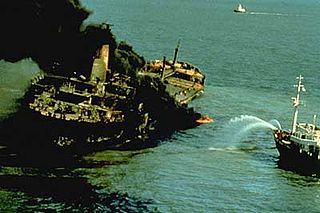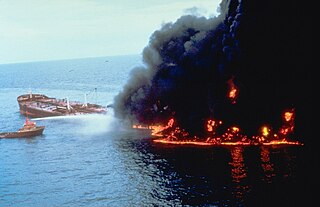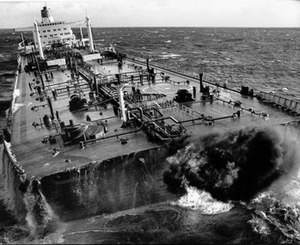A double-hulled tanker refers to an oil tanker which has a double hull. They reduce the likelihood of leaks occurring compared to single-hulled tankers, and their ability to prevent or reduce oil spills led to double hulls being standardized for oil tankers and other types of ships including by the International Convention for the Prevention of Pollution from Ships or MARPOL Convention. After the Exxon Valdez oil spill disaster in Alaska in 1989, the US government required all new oil tankers built for use between US ports to be equipped with a full double hull.
![<span class="mw-page-title-main">K Line</span> Former Japanese shipping company, now [[Ocean Network Express]]](https://upload.wikimedia.org/wikipedia/commons/b/bf/K-stack.jpg)
Kawasaki Kisen Kaisha, Ltd. is a Japanese transportation company. It owns a fleet that includes dry cargo ships, container ships, liquefied natural gas carriers, Ro-Ro ships, tankers, and container terminals. It used to be the fourteenth largest container transportation and shipping company in the world, before becoming part of Ocean Network Express in 2017.
A double hull is a ship hull design and construction method where the bottom and sides of the ship have two complete layers of watertight hull surface: one outer layer forming the normal hull of the ship, and a second inner hull which is some distance inboard, typically by a few feet, which forms a redundant barrier to seawater in case the outer hull is damaged and leaks.
SS Atlantic Empress was a Greek oil tanker that in 1979 collided with the oil tanker Aegean Captain in the Caribbean, and eventually sank, having created the fifth largest oil spill on record and the largest ship-based spill having spilled 287,000 metric tonnes of crude oil into the Caribbean Sea. It was built at the Odense Staalskibsværft shipyard in Odense, Denmark, and launched on 16 February 1974.

MVNew Carissa was a freighter that ran aground and broke apart on a beach near Coos Bay, Oregon, United States, during a storm in February 1999. An attempt to tow the bow section of the ship out to sea failed when the tow line broke, and the bow was grounded again. Eventually, the bow was successfully towed out to sea and sunk. The stern section remained on the beach for over nine years until was dismantled and removed in 2008.

Pasha Bulker, later known as MV Drake and now MV Anthea, is a Panamax bulk carrier of 76,741 tonnes deadweight (DWT) operated by the Lauritzen Bulkers shipping company and owned by Japanese Disponent Owners. While waiting in the open ocean outside Newcastle harbour to load coal, Pasha Bulker ran aground during a major storm on 8 June 2007 on Nobbys Beach, New South Wales, Australia. It was refloated and moved to a safe location offshore on 2 July 2007 before being towed to Japan for major repairs on 26 July 2007.

The Prestige oil spill occurred off the coast of Galicia, Spain in November 2002, caused by the sinking of the 26-year-old, structurally deficient oil tanker MV Prestige, carrying 77,000 tonnes of heavy fuel oil. During a storm, it burst a tank on 13 November, and French, Spanish, and Portuguese governments refused to allow the ship to dock. The vessel subsequently sank on 19 November, about 210 kilometres (130 mi) from the coast of Galicia. It is estimated that it spilled 60,000 tonnes or a volume of 67,000 m3 (17.8 million US gal) of heavy fuel oil.

An oil tanker, also known as a petroleum tanker, is a ship designed for the bulk transport of oil or its products. There are two basic types of oil tankers: crude tankers and product tankers. Crude tankers move large quantities of unrefined crude oil from its point of extraction to refineries. Product tankers, generally much smaller, are designed to move refined products from refineries to points near consuming markets.
Oil tankers generally have from 8 to 12 tanks. Each tank is split into two or three independent compartments by fore-and-aft bulkheads. The tanks are numbered with tank one being the forwardmost. Individual compartments are referred to by the tank number and the athwartships position, such as "one port", "three starboard", or "six center."
Katina P was a Greek oil tanker carrying 72,000 tonnes of oil which sank off the Mozambique coast on 26 April 1992.

The M/T Burmah Agate was an oil tanker that was involved in a nautical collision and subsequent oil spill near Galveston, Texas in November 1979. 31 crewmen were killed in the collision, and the oil spill damaged the local environment.
The Venpet–Venoil collision was a maritime accident involving sister supertankers; the Liberian-registered Venoil and Venpet, in dense fog off the coast of South Africa on 16 December 1977. The tankers were travelling in opposite directions; the Venoil fully laden with over 250,000 tonnes of crude oil bound for Halifax, Canada, and the Venpet, travelling in ballast, headed for Kharg Island, Iran. The Venoil ploughed into the Venpet, eventually leading to the spilling of approximately 26,600–30,500 tonnes of crude oil. The tankers were sister ships owned and operated by Bethlehem Steel Corporation. Both ships were manned by Taiwanese crews.
The Oswego-Guardian–Texanita collision was a maritime accident between two supertankers near Stilbaai, South Africa on 21 August 1972. The Texanita exploded and sank with the loss of 47 men, while a further life was lost on the Oswego Guardian. The accident was a catalyst for change to marine traffic separation procedures as well as oil tanker inerting.
The SS Wafra oil spill occurred on 27 February 1971, when SS Wafra, an oil tanker, ran aground while under tow near Cape Agulhas, South Africa. Approximately 200,000 barrels of crude oil were leaked into the ocean. The larger part of the ship was refloated, towed out to sea, and then sunk by the South African Air Force to prevent further oil contamination of the coastline.

The Mega Borg oil spill occurred in the Gulf of Mexico on June 8, 1990, roughly 50 miles off the coast of Texas, when the oil tanker Mega Borg caught on fire and exploded. The cleanup was one of the first practical uses of bioremediation.
In June 1966, the British oil tanker MV Alva Cape caught fire twice in New York Harbor, first in a collision with tanker SS Texaco Massachusetts, and next while unloading cargo, and was subsequently scuttled offshore. Thirty-three people were killed in the collision, the resulting spill of its cargo of naphtha and major fire that ensued. Four more were killed about two weeks later while the emptied tanks were being inerted with carbon dioxide in a misguided attempt to make the damaged vessel safe for transport.
In late December 1989 and early January 1990, an estimated 70,000 tons of crude oil spilled from the Iranian oil tanker Khark 5 after she suffered a hull breach on 19 December in the mid Atlantic Ocean off of Morocco.
MT New Diamond is a very large crude carrier. On 3 September 2020, the ship caught fire off the western coast of Sri Lanka, resulting in the death of a Filipino crew member. After burning intermittently for almost a week, the fire was reported to be extinguished by 11 September. In July 2021 the ship was beached at Gadani Ship Breaking Yard.

![<span class="mw-page-title-main">K Line</span> Former Japanese shipping company, now [[Ocean Network Express]]](https://upload.wikimedia.org/wikipedia/commons/b/bf/K-stack.jpg)





